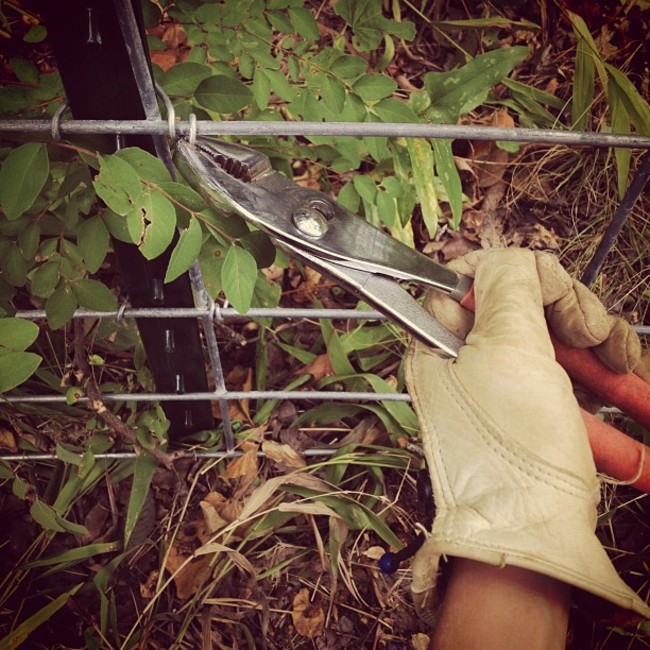 My lovely wife putting on the finishing touches
My lovely wife putting on the finishing touches
Male animals on the farm are a difficult proposition. They’re harder to manage, they’re stronger and they generally only have one thing on their mind. Yet you need them to make milk. If you don’t have babies you don’t have milk. So we needed some bucks to help us breed our ladies this fall for milk in the spring.
Enter Gozer and George. One is a Nubian (such as Bridget) and one is an Alpine (such as Mayday and Sabine, Queen of the Truck Roof). Both have excellent blood lines for milk production, which is a critical quality for our bucks. They are responsible for 50% of the genetics in our herd. Each doe has less of an impact than the bucks. Yet neither buck has produced kids, so we can’t be sure that their progeny will be up to par. But that’s the risk you take with bucks. No one wants to sell you their best buck, you almost always have to go with an unproven youngin’ from good blood lines.
The Buck Bachelor Pad
In preparation for the bucks we needed to put together a highly secure pen. When they are in “rut” they are very difficult to maintain and generally try to escape out of anywhere in order to find their mates. We’ve seen a variety of set-ups and heard both good and bad stories. For our bucks here’s what we did:
We took 12 lengths of cattle panel (each 16’ long and 4’ high) and made a 32’ by 64’ pen. This is much bigger than any buck pen we’ve seen. For some reason bucks are typically confined to a much smaller area. I suppose we’ll learn why in short order, but for now we didn’t see any reason to make a small pen for them.
When they’re not in rut I’d like to try rotationally grazing them during the day, but I’m not so sure about it quite yet. If one were to escape it would be a lot harder to capture him than it would a doe. I've also never seen a farm that rotationally grazes the bucks (maybe a reader has and can refer us?), let alone just lets them graze outside the pen, period. They're always in the pen.
Inside the pen we ran a very hot strand of electric polywire. I generally test the fence to see how hot it is and on this occasion I was very sorry to have touched that wire. It felt like someone hit my hand with a 2x4. I touched it again today by accident. I really hope that doesn’t happen again. The wire runs about 2” inside and above the cattle panel and hangs from attachments that connect to the top of the t-posts. That way if the bucks climb up on the fence and try to climb over they quickly learn it’s not a good idea. By having it extend inside the pen they are less likely to attempt jumping out.
 Buck pen, although this was before we put up the hot wire
Buck pen, although this was before we put up the hot wire
The pen is located on the edge of the woods so that they have natural shade and trees to rub up against. We built a shelter for them that is flanked by a couple trees on the South side and thus they should be protected from the winds and the storms, which usually come in from the SW. One of their first nights on the farm we had the craziest thunderstorm that either of us have been through (I still have scratch marks) and the bucks emerged in the morning completely dry, so that was good. In the winter I may put some wood sides on it to be sure they keep warm.
Feeding the bucks is a whole different issue. One I didn’t anticipate. They aren’t out grazing all day (yet). So what do they eat? Our whole philosophy is to have the animals out on pasture, foraging their own food, but can that be the case with the male animals? I don’t know, but I’ll share some ideas about how they’re currently being fed in a future post.



